#cell receptors
Text
Prostanoids enemies forever: we'll keep on fighting (IL-)2 exhaustion 'TIL cancer cells will die
Tumors actively prevent the formation of immune responses by so-called cytotoxic T cells, which are essential in combating cancer. In cancer, tumors often impair the body’s immune response. For example, they can prevent immune cells from perceiving cancer cells as a threat or render them inactive. Immunotherapies aim to overcome these mechanisms and stimulate the immune system, in particular the…

View On WordPress
#cancer cells#cell receptors#checkpoint therapy#immune receptor#immune response#interleukin-2#lymphocytes#prostaglandin E2
0 notes
Text
Uncle Sam paid to develop a cancer drug and now one guy will get to charge whatever he wants for it

Today (Oct 19), I'm in Charleston, WV to give the 41st annual McCreight Lecture in the Humanities. Tomorrow (Oct 20), I'm at Charleston's Taylor Books from 12h-14h.

The argument for pharma patents: making new medicines is expensive, and medicines are how we save ourselves from cancer and other diseases. Therefore, we will award government-backed monopolies – patents – to pharma companies so they will have an incentive to invest their shareholders' capital in research.
There's plenty wrong with this argument. For one thing, pharma companies use their monopoly winnings to sell drugs, not invent drugs. For every dollar pharma spends on research, it spends three dollars on marketing:
https://www.bu.edu/sph/files/2015/05/Pharmaceutical-Marketing-and-Research-Spending-APHA-21-Oct-01.pdf
And that "R&D" isn't what you're thinking of, either. Most R&D spending goes to "evergreening" – coming up with minor variations on existing drugs in a bid to extend those patents for years or decades:
https://www.ncbi.nlm.nih.gov/pmc/articles/PMC3680578/
Evergreening got a lot of attention recently when John Green rained down righteous fire upon Johnson & Johnson for their sneaky tricks to prevent poor people from accessing affordable TB meds, prompting this excellent explainer from the Arm and A Leg Podcast:
https://armandalegshow.com/episode/john-green-part-1/
Another thing those monopoly profits are useful for: "pay for delay," where pharma companies bribe generic manufacturers not to make cheap versions of drugs whose patents have expired. Sure, it's illegal, but that doesn't stop 'em:
https://www.ftc.gov/news-events/topics/competition-enforcement/pay-delay
But it's their money, right? If they want to spend it on bribes or evergreening or marketing, at least some of that money is going into drugs that'll keep you and the people you love from enduring unimaginable pain or dying slowly and hard. Surely that warrants a patent.
Let's say it does. But what about when a pharma company gets a patent on a life-saving drug that the public paid to develop, test and refine? Publicly funded work is presumptively in the public domain, from NASA R&D to the photos that park rangers shoot of our national parks. The public pays to produce this work, so it should belong to the public, right?
That was the deal – until Congress passed the Bayh-Dole Act in 1980. Under Bayh-Dole, government-funded inventions are given away – to for-profit corporations, who get to charge us whatever they want to access the things we paid to make. The basis for this is a racist hoax called "The Tragedy Of the Commons," written by the eugenicist white supremacist Garrett Hardin and published by Science in 1968:
https://memex.craphound.com/2019/10/01/the-tragedy-of-the-commons-how-ecofascism-was-smuggled-into-mainstream-thought/
Hardin invented an imaginary history in which "commons" – things owned and shared by a community – are inevitably overrun by selfish assholes, a fact that prompts nice people to also overrun these commons, so as to get some value out of them before they are gobbled up by people who read Garrett Hardin essays.
Hardin asserted this as a historical fact, but he cited no instances in which it happened. But when the Nobel-winning Elinor Ostrom actually went and looked at how commons are managed, she found that they are robust and stable over long time periods, and are a supremely efficient way of managing resources:
https://pluralistic.net/2023/05/04/analytical-democratic-theory/#epistocratic-delusions
The reason Hardin invented an imaginary history of tragic commons was to justify enclosure: moving things that the public owned and used freely into private ownership. Or, to put it more bluntly, Hardin invented a pseudoscientific justification for giving away parks, roads and schools to rich people and letting them charge us to use them.
To arrive at this fantasy, Hardin deployed one of the most important analytical tools of modern economics: introspection. As Ely Devons put it: "If economists wished to study the horse, they wouldn’t go and look at horses. They’d sit in their studies and say to themselves, ‘What would I do if I were a horse?’"
https://pluralistic.net/2022/10/27/economism/#what-would-i-do-if-i-were-a-horse
Hardin's hoax swept from the fringes to the center and became received wisdom – so much so that by 1980, Senators Birch Bayh and Bob Dole were able to pass a law that gave away publicly funded medicine to private firms, because otherwise these inventions would be "overgrazed" by greedy people, denying the public access to livesaving drugs.
On September 21, the NIH quietly published an announcement of one of these pharmaceutical transfers, buried in a list of 31 patent assignments in the Federal Register:
https://public-inspection.federalregister.gov/2023-20487.pdf
The transfer in question is a patent for using T-cell receptors (TCRs) to treat solid tumors from HPV, one of the only patents for treating solid tumors with TCRs. The beneficiary of this transfer is Scarlet TCR, a Delaware company with no website or SEC filings and ownership shrouded in mystery:
https://www.bizapedia.com/de/scarlet-tcr-inc.html
One person who pays attention to this sort of thing is James Love, co-founder of Knowledge Ecology International, a nonprofit that has worked for decades for access to medicines. Love sleuthed out at least one person behind Scarlet TCR: Christian Hinrichs, a researcher at Rutgers who used to work at the NIH's National Cancer Institute:
https://www.nih.gov/research-training/lasker-clinical-research-scholars/tenured-former-scholars
Love presumes Hinrichs is the owner of Scarlet TCR, but neither the NIH nor Scarlet TCR nor Hinrichs will confirm it. Hinrichs was one of the publicly-funded researchers who worked on the new TCR therapy, for which he received a salary.
This new drug was paid for out of the public purse. The basic R&D – salaries for Hinrichs and his collaborators, as well as funding for their facilities – came out of NIH grants. So did the funding for the initial Phase I trial, and the ongoing large Phase II trial.
As David Dayen writes in The American Prospect, the proposed patent transfer will make Hinrichs a very wealthy man (Love calls it "generational wealth"):
https://prospect.org/health/2023-10-18-nih-how-to-become-billionaire-program/
This wealth will come by charging us – the public – to access a drug that we paid to produce. The public took all the risks to develop this drug, and Hinrichs stands to become a billionaire by reaping the rewards – rewards that will come by extracting fortunes from terrified people who don't want to die from tumors that are eating them alive.
The transfer of this patent is indefensible. The government isn't even waiting until the Phase II trials are complete to hand over our commonly owned science.
But there's still time. The NIH is about to get a new director, Monica Bertagnolli – Hinrichs's former boss – who will need to go before the Senate Health, Education, Labor and Pensions Committee for confirmation. Love is hoping that the confirmation hearing will present an opportunity to question Bertagnolli about the transfer – specifically, why the drug isn't being nonexclusively licensed to lots of drug companies who will have to compete to sell the cheapest possible version.

If you'd like an essay-formatted version of this post to read or share, here's a link to it on pluralistic.net, my surveillance-free, ad-free, tracker-free blog:
https://pluralistic.net/2023/10/19/solid-tumors/#t-cell-receptors


My next novel is The Lost Cause, a hopeful novel of the climate emergency. Amazon won't sell the audiobook, so I made my own and I'm pre-selling it on Kickstarter!
#pluralistic#pharma#incentives dont matter#incentives matter#drugs#uspto#nih#national institutes of health#cancer#patents#kei#knowledge ecology international#james love#jamie love#bayh-dole#bayh-dole act#tcr#scarlet tcr#t-cell receptor#Christian Hinrichs#entrepreneurial state#human papillomavirus#hpv#solid tumors#monopolies
548 notes
·
View notes
Text
Pitch: Cells at Work spinoff about a trans person undergoing HRT
little sex hormone gijinkas running around flipping switches like a 1930s musical, the rest of the cells going, "Well, shit, new orders I guess, get to work on those hair follicles."
#transgender#cells at work#uptake inhibitors are all burly union workers forming a picket line around the hormone receptors
206 notes
·
View notes
Text

#shitpost#immunology#immunology shitposting#meme#mhc#b cell receptor#bcr crosslinking#this meme brought to you by my mom and I making fun of a question on a quiz I had for literature class#where one of the questions was ‘which of these is NOT a feature of the Greek underworld’#and I guess the professor just picked a random Greek sounding word but the specific word they picked was leukocyte#so we were pretending that leukocytes were in different literary traditions#and that morphed into talking about ‘immuno-christian values’ and I got inspired to throw this nonsense together
80 notes
·
View notes
Text
Absorption of light allows 11-cis-retinal to relax from a bent shape (arising from the cis double bond) to a lower energy, all-trans arrangement. The straighter all-trans-retinal can no longer fit in the receptor designed for 11-cis-retinal and is ejected. This change leads to differences in cell membrane potential and, as ions are pumped into the cell, this response turns into a nerve impulse that travels to the brain. That is not the end of the matter; the all-trans-retinal generated by this process is reconverted to 11-cis-retinal by specific enzymes, which can re-bind into the receptor, ready to interact with another photon of light.
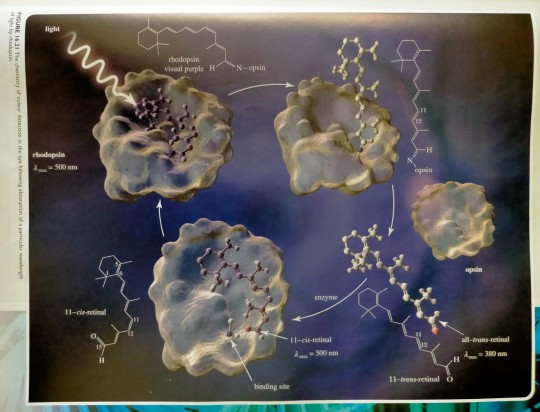
FIGURE 16.21 The chemistry of colour detection in the eye following absorption of a particular wavelength of light by rhodopsin.
"Chemistry" 2e - Blackman, A., Bottle, S., Schmid, S., Mocerino, M., Wille, U.
#book quote#chemistry#nonfiction#textbook#light absorption#light#wavelength#rhodopsin#cis#trans#cell membrane#retinal#receptor#enzyme#opsin#photon#straight#oops all trans
38 notes
·
View notes
Text

#biology memes#studyblr#autoimmunity#i love nerd humor#my creativity peaked at their hair as t cell receptors#anyway studying for finals is going well
14 notes
·
View notes
Text
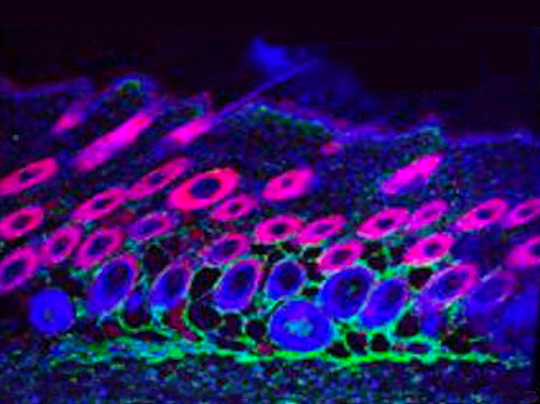
Ahead on Hair
Maintaining healthy hair follicles and regenerating them after damage is dependent on molecules of the immune system called Toll-like receptors in hair follicle stem cells – insight for tackling hair loss
Read the published research article here
Image from work by Luyang Xiong and colleagues
Department of Neurosciences, Lerner Research Institute, Cleveland Clinic; Cleveland, OH, USA
Image originally published with a Creative Commons Attribution 4.0 International (CC BY 4.0)
Published in eLife, January 2024
You can also follow BPoD on Instagram, Twitter and Facebook
#science#biomedicine#immunofluorescence#biology#stem cells#hair#hair follicles#baldness#hair loss#toll-like receptors
10 notes
·
View notes
Text
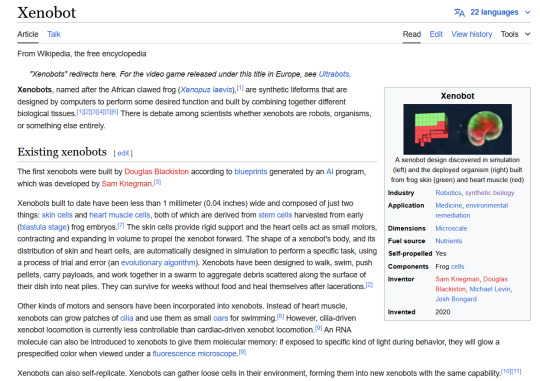
the fact that these things actually exist in real life is so crazy to me .
#reminds me of an article i saw on a newly developed leukemia treatment now being used in nürnberg#where a patients t-cells are filtered out of the blood and then sent to a lab that genetically modifies them#equipping them with a receptor that gives them the ability to recognize and kill cancer cells#and then they're reintroduced to the blood resulting in a 40% increased survival rate for previously hopeless cases. CRAZEYYYYYYY
4 notes
·
View notes
Text
Today has not been productive at all…maybe a berry banana smoothie will fix me
2 notes
·
View notes
Photo
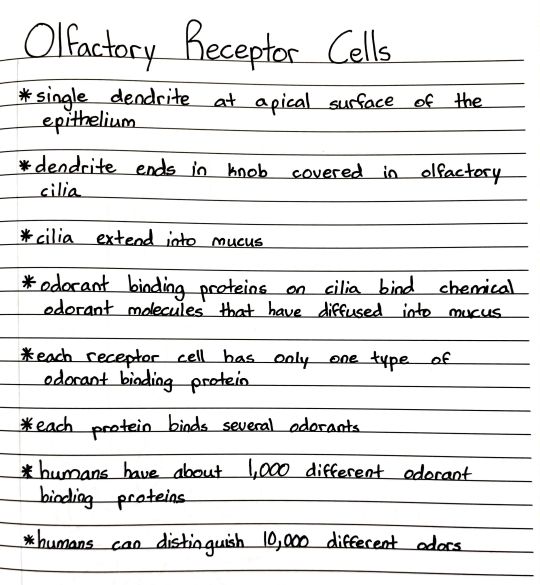
#studyblr#notes#medblr#medical notes#med notes#biology#biology notes#bio#bio notes#olfactory receptor cells#receptor cells#olfaction#human senses#sensory#sensory organs#dendrites#dendrite cells#proteins#epithelium#epithelial cells#epithelial tissue
17 notes
·
View notes
Text
Trailblazing Triumphs: CAR T-Cell Therapy Market Successes 2033

In 2022, the global Chimeric Antigen Receptor (CAR) T-Cell Therapy Market was valued at US$ 2.54 billion, and is poised for substantial growth. Forecasts predict that the market will expand to US$ 3.5 billion by 2023 and is projected to reach an impressive US$ 6.82 billion by 2033, maintaining a steady CAGR of 6.9% from 2023 onwards.
This remarkable trajectory is primarily attributed to advancements in technology and the escalating demand for personalized treatment options. Notably, from 2018 to 2022, the CAR T-cell therapy market witnessed a robust growth at a CAGR of 7%.A distinguishing feature of CAR T-cell therapy lies in its remarkable efficacy.
Clinical trials have demonstrated response rates of up to 90% in certain leukemia and lymphoma cases, a substantial leap compared to conventional cancer treatments which typically yield response rates averaging 20-30%.
Click Here to Access Your Visuals-Packed Report!https://www.futuremarketinsights.com/reports/sample/rep-gb-16808
0 notes
Text
Cellular fate and energy factories: unraveling how surface receptors meet mitochondria for brain cell survival
The human brain is an organ that takes nearly from 20 to 25% of the energy the body needs. This high energy demand for neuronal functions depends on the transport and precise distribution of mitochondria — the energy-generating cell organelles — in each neuron. In neurons, the transport process of mitochondria is determining, since these organelles must be present along all axons and dendrites to…
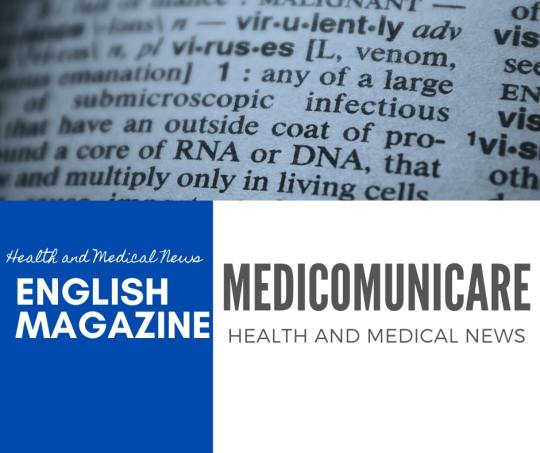
View On WordPress
#beta-amyloid#cell receptors#cognitive decline#endoplasmic reticulum#epilepsy#G protein#mitochondria#neurodegeneration#sistema immunitario#tau protein
0 notes
Text
Descubren "Interruptor de Apagado" que Puede Desencadenar la Muerte de Células Cancerígenas
Científicos del Centro Integral de Cáncer de la UC Davis en Sacramento, California, han identificado lo que describen como un “interruptor de apagado” capaz de provocar la muerte de las células cancerígenas. Este hallazgo, detallado en un estudio publicado el mes pasado en la revista Cell Death & Differentiation, revela una nueva esperanza en la lucha contra el cáncer.
En el estudio, los…

View On WordPress
#Cell Death & Differentiation#Células cancerígenas#Centro Integral de Cáncer de la UC Davis#Ensayos clínicos#Epítopo#Experimento#Inmunoterapia contra el cáncer#Meager success#Potencial terapéutico#Receptor CD95 (Fas)#Receptores de la muerte#Telereald#Terapia de células T CAR (receptor de antígeno quimérico)#Terapias tradicionales contra el cáncer#Tumores sólidos
0 notes
Text
todays lesson in (on?) caffeine consumption: caffeine affects my antidepressant. the higher my caffeine intake, the stronger the effect of my anti depressant, the better my mood, the hornier i get
but also the stronger the effect of my anti depressant the less my body reacts to sexual touch 🥲
#evil side effect honestly#I'm taking it off-lable to protect the pain receptors/ nerve cells in my abdomen#it's a long story but it works for many chronic pain patiens it certainly works really well for me#IF IT WASNT FOR THE CAN'T-DO-ANYTHING-ABOUT-HOW-MENTALLY-BUT-NOT-PHYSICALLY-TURNED-ON-YOU-ARE#anyway the lesson here is that I'm incredibly amped up so if anyone sends me suggestive messages today imma jump through the screen#(affectionate)#(explicit permission)#🔘
1 note
·
View note
Text
How to sleep well and how to stay awake longer when awake
Our capacity for concentration, alertness, and emotional stability is reset by sleep. Consequently, it is of utmost significance.
When we are awake, what we do affects how quickly we fall asleep, whether we stay asleep or not, and how we feel when we get up the next day. Therefore, obtaining a truly good night's sleep every night is crucial.
Our neurological system and body produce more adenosine the more time we spend being awake. It induces something like a sleep urge or a hunger. Adenosine keeps progressively increasing the longer we have been awake, which is why we feel drowsy.
Adenosine is similar to caffeine. Caffeine suppresses the receptor for sleepiness when it is consumed because it binds to the adenosine receptor. Adenosine will attach to that one receptor once the caffeine wears off, causing a crash and increased fatigue (tiredness).
While caffeine can be beneficial for some people, it can also pose health risks for others. Dopamine is a neuromodulator that caffeine enhances. Dopamine is related to the neuromodulator epinephrine, which is produced from dopamine, and it tends to make us feel pleasant, driven, and energetic.
Adenosine, which is produced naturally, is what causes sleepiness. Caffeine blocks the receptor that gives us energy and raises dopamine, preventing adenosine from having its effect of making us feel drowsy. We feel more hungry when adenosine levels are high, and we don't feel hungry when adenosine levels are low.
There is a second force, known as the circadian force, that controls when we are asleep and are awake. However, light has the most influence over when we desire to sleep and wake up.
A molecule called hormone is released from one organ in the body and travels to other parts of the body, including the neurological system, where it works on other organs.
Due to the presence of the hormone cortisol in the adrenal glands, we wake up in the morning. We feel awake because of a pulse of epinephrine (adrenaline) coming from our adrenal glands and our brain. It has a tendency to alert the body's entire system. This pulse should only happen throughout the day, not in the night.
The morning is when that cortisol pulse starts to increase in intensity. Additionally, a clock is set in our bodies and nervous systems that determines when a different hormone called melatonin, which make us feel sleepy, will be released from a specific region of the brain, the pineal gland, roughly 12 to 14 hours later. There are therefore two signals: a wakefulness signal that starts the timer for the second signal, sleepy signal, and two signals altogether.
Additionally, melatonin delays the start of puberty. Melatonin releases chronically in newborns, suppressing the other brain chemicals. We tend to exit puberty about the time that we start producing melatonin at night.
One thing to bear in mind is that melatonin only aids in sleep onset; it has no effect on sleep maintenance.
Cortisol and melatonin are constantly in rhythm with one another. When that cortisol will start to rise depends on a certain factor affecting our nerve system.
As soon as we open our eyes in the morning, light enters. We have retinal ganglion cells in our eyes, known as brain neurons, that detect a certain sort of light and interact with the superchiasmatic nucleus, a clock that is located directly over the roof of our mouth and that connects to basically every cell and organ in our body.
Our body's internal clock (neurons) reacts to the specific type and quantity of light that comes from sunlight.
There will be extremely wide-ranging and detrimental impacts on cardiovascular health, dementia, metabolic effects, learning, depression, and many other things if cortisol and melatonin do not function effectively as needed.
Many anxiety and depression problems could also be brought on by a late cortisol level increase.
We should go outside and spend some time in the sun to set the circadian clock so that there is plenty of blue and yellow light hitting the retina early in the day. Artificial blue lights will work best for setting this mechanism if there are heavier dark clouds. Additionally, as blue light suppresses melatonin throughout the day, we should wear blue light blocking eyewear at night.
Sunlight prevents the pineal gland from releasing melatonin. darkness allows the pineal to release melatonin. So, we should get up, go outside and get that sunlight for at least 5 to 10 minutes on a regular basis.
We don't need to see or perceive the sun for this mechanism to function; rather, it is a subconscious process by which certain neurons, known as melanopsinganglion cells, set our central clocks by becoming activated by a specific wavelength of light that is present in the atmosphere.
Therefore, it is essential to view light in the morning, ideally sunlight, in order to create good sleep-wake rhythms and enable us to sleep well at night.
The timing of food intake, timing of exercise, and numerous pharmaceuticals and substances that one might ingest are the other factors besides light, but the light is the sole direct input to the clock.
Another structure, the intergeniculate leaflet, is located a few millimeters distant in the brain and is important in controlling the clock output during that are known as non-photic, non-light type impacts, such as exercises, feeding, and other similar activities.
According to a study, watching sunlight around the time of sunset mitigates some of the negative effects of light by delaying the release of melatonin later that evening.
Our retina and those cells become more sensitive to light the longer we have been awake.
Between 11 pm and 4 am, roughly, light enters the eyes and decreases the release of dopamine, which can impede learning and have a variety of other negative effects.
Controlling our nighttime light exposure behavior and avoiding excessive or strong light exposure in the middle of the night is one method we can support our mechanisms for good mood, mental health, learning focus, metabolism, etc.
Since most of these cells are located in the bottom half of our retina, they are observing the area around us that is visible from above. Therefore, we ought to maintain the light source nearby, either on the ground or a desk. The optimum lighting will be low-level, dim lighting because it won't excite neurons, which would change the circadian rhythm. Candlelight, campfires, and fireplaces are acceptable, and the environment can also have low lighting.
The overall amount of time spent sleeping and the time when we feel drowsy are both advanced if we switch on the lights before waking up. We want to go to bed earlier every night because of that.
Many people take afternoon naps to rest their bodies, which can be beneficial to some people but detrimental to others.
Instead of taking a nap, we can practice yog nidra, which enables us to intentionally put our body and mind into a deep state of relaxation. Depending on the practice, we may or may not fall asleep. This is carried out for periods of 10 to 30 or even 60 minutes.
It includes pausing for 10 to 30 minutes while listening to a script, and it has to do with specific breathing patterns that can significantly aid people in learning to relax in order to go asleep. It's a method of self-training that enable us to get our nerve systems to shift from the state of heightened alertness to the condition of heightened relaxation that we desire.
Dopamine and other neuromodulators can reset themselves through yoga nidra and meditation, which enhances our sleep.
#health#sleep#hormones#adenosine#dopamine#serotonin#sleepiness#caffeine#epinephrine#receptors#cortisol#pineal gland#melatonin#healthybody#cells#retina#sunlight#bluelight#subconscious#consciousness#neurons#metabolism#environment#meditation#mindset#overall health#relaxation
0 notes
Text
Upon binding of Nod factors, SYMRK is thought to activate subsequent steps shared by these associations, including fluctuations in the calcium concentration, called calcium spiking, inside and around the nucleus of the infected epidermal cell, which causes the activation of the core symbiotic genes (Figure 23.3).

"Plant Physiology and Development" int'l 6e - Taiz, L., Zeiger, E., Møller, I.M., Murphy, A.
#book quotes#plant physiology and development#nonfiction#textbook#nod factors#nodulation factors#symrk#symbiosis receptor like kinase#fluctuations#calcium#epidermis#plant cells#infection#core symbiotic genes#root hair#pea#pisum sativum#fluorescence
0 notes